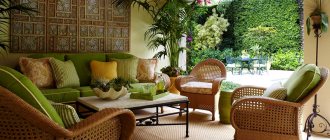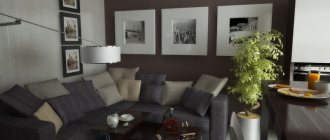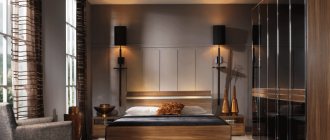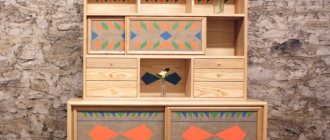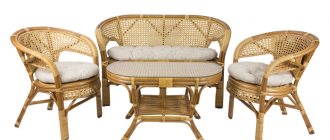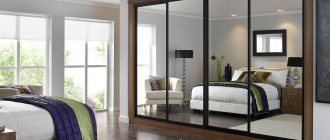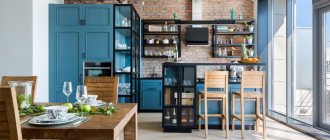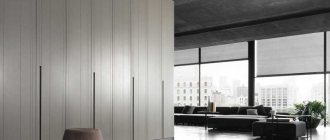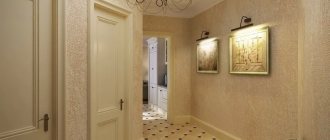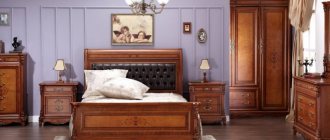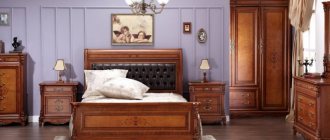Help the site, share with friends:
This year’s new hit is the use of wicker furniture in interior design. Most often, this type of furniture is used in private housing construction, cottages and country estates.
Thanks to the reliability and durability of its design, which allows it to withstand large temperature changes, comfortable and relatively inexpensive furniture is perfect for attics, verandas or gazebos.
However, the range of wicker furniture is not limited only to outdoor furniture; nowadays there is a wide variety of furnishings created using the wicker technique.
Among the wicker products, the most popular are bedroom furnishings, which include a bed or hammock, living room interior items, this group includes an armchair, a coffee table and a sofa, a kitchen group with stools and a table.
When deciding how to choose wicker furniture, you need to decide what kind of furniture you need, what design it should have and what materials you prefer.
It is also necessary to take into account the design features of different types of wicker furniture and product manufacturers.
It depends, first of all, on where exactly you will use wicker items, in the country, in the kitchen or on the street. Because the necessary parameters depend on this.
What is special about rattan furniture?
Any natural material has a number of excellent qualities unique to it. Nothing can compare with rattan in terms of plasticity. This is a tree-like vine native to Southeast Asia.
It has long been used to make chairs, low tables and stools, which were highly valued by the Chinese and Japanese emperors.
Note! The natural material is absolutely environmentally safe, so wicker rattan furniture without painting is recommended even for allergy sufferers and asthmatics.
Rattan garden furniture is very popular today. In the summer, it can decorate a covered gallery, veranda or open terrace in any weather.
Popular openwork furniture sets made from Asian vines are constantly growing, although prices for rattan furniture are quite high. This is understandable - the original design, low weight and high strength of the “braid” put it on par with the best examples from elite catalogs.
Some people manage to master the technology of weaving furniture from wicker and reeds. Exclusive handmade cabinets, chairs, armchairs and sofas look quite presentable.
Note! Natural rattan is very expensive, since the tree-like vine grows in hard-to-reach places. Procurement of raw materials does not meet all the needs of the global furniture industry. The length of the vine can reach several meters, the width is about 5-7 cm, but not the entire stem is suitable for furniture production.
Artificial vine is a budget alternative. Connoisseurs of natural materials argue that artificial rattan furniture is inferior in aesthetics, but it is more resistant to adverse factors.
Combined designs
Universal and stylish sets of garden furniture, created with your own hands or purchased in special stores, can be made from combined materials.
For this, supporting structures made of metal are used, and some surfaces are glass, plastic or made of other materials.
Wooden pallets are often used for hand-made furniture, and a set of garden furniture can be made from fallen trees.
Old benches and benches are suitable for arranging comfortable and practical swings, and home furniture, provided it is properly remodeled, can be installed in the garden.
Rattan processing technology
Manufacturers of openwork sets admit that artificial materials are more pliable than rattan. It takes a long time to evaporate and bend it using a special technology. Then the parts are fastened in a special way by bandaging, this takes a lot of time.
Synthetic “vine” saves time and effort - no preliminary preparation of raw materials is required for the manufacture of new things.
Often craftsmen have to restore antique rattan furniture, replacing several parts. In this case, the replacement of material will be obvious. It is necessary to replace symmetrical parts or “braid” on the backs of chairs, armchairs and sofas.
When making rattan models, I use parts of different shapes:
- Stripes;
- Rods;
- Braid:
- Crescent.
The synthetic counterpart varies in length, thickness and surface texture. This gives more opportunities when producing original furniture samples.
The rattan vine is cleared of bark and sorted by thickness. Steam treatment makes it elastic. Then the stems are split, polished, stretched or rounded with special devices. When dry, the Asian vine “remembers” the shape given to it. Holes are carefully drilled into it to connect the parts into a single product.
This is interesting! The most popular product is the “Viennese chair”. When falling from a height, it did not break into pieces, but turned over and stood on its legs. Soon, bent-back chairs began to be made from ordinary wood, but the original technology for making this type of rattan furniture was lost.
Trimmings and shavings are not thrown away. It’s easy to make “lattices” for the back of a chair or a tabletop for a coffee table from bark and twigs. Finishing with wood varnish makes rattan garden furniture stronger and more durable.
Colors
Of course, the design of wicker furniture is varied, but there is a tendency to use colored coverings for this type of furnishings. So, wicker furniture in white colors will harmoniously fit into a country estate.
As for massive furniture, which includes a bed or living room furniture, you should leave them in natural colors.
Also, in small apartments it is better to limit yourself to wickerwork in natural colors, otherwise it will overload an already small room.
Advantages of furniture made from natural and artificial materials
Openwork furniture sets are, as a rule, design accents in any interior. She gets all the attention. Therefore, it is worth asking where to buy rattan furniture in your region.
Helpful advice! If landscaping work is in full swing at your summer cottage, distract the guests of honor with a picnic and lunch in the fresh air. Use luxury garden furniture that you rent.
Furniture made of artificial rattan is undemanding in maintenance; it must be periodically wiped with a damp sponge.
It would be useful to list the advantages of openwork furniture made from Asian vines:
- Environmentally friendly material;
- Light weight - even a child or a person with poor health can move it independently;
- The lightweight furniture set can be taken with you to the dacha and then returned home to a furnished loggia; its compact shape simplifies transportation;
- The material is resistant to changes in temperature and humidity, does not fade in the sun, and will not become limp from rain;
- A rich palette close in shades to natural wood - from bleached oak to wenge wood.
Among the “disadvantages” we can point out that furniture sets made from natural materials cannot be left in the cold, especially after a rainstorm. Chairs and armchairs should not be placed near a fireplace or other open fire - they may catch fire.
Important! Rattan can be impregnated with stain and varnished in any shade. Products in light and chocolate shades, as well as white openwork furniture, look best.
Decor
To update the existing interior and create a comfortable environment in a furnished room, it is enough to replace some decorative elements. Wicker products - baskets, trays, bedside tables, tables or chairs - are perfect for these purposes.
A coffee table with a glass top is universally integrated into the interior of any style. In combination with transparent surfaces, rattan in the interior acquires amazing properties. You get the feeling that this element of decor has always been present here, the atmosphere becomes so cozy. And adding pillows and blankets in the appropriate style to the sofa standing next to it will add some comfort.
Rattan furniture in the interior
Wicker furniture made from wicker and a polymer substitute is much cheaper than samples from Asian vine, but it is not inferior in beauty and grace. Not every specialist will be able to determine in a photo of rattan furniture which is “synthetic” and which is a natural material.
Note! Some seats are not designed to bear a lot of weight - these are purely decorative designs. The maximum mass of a person sitting on such a chair should be indicated in the description of the sample from the catalog. In most cases, openwork furniture can withstand up to 120 kg of weight.
Many models have something in common, but there are product items that can impress the most discerning buyer. For rattan furniture like the one in the photo, you wouldn’t mind spending money to change the interior style.
Having mastered the technology of weaving chairs from Asian and willow wicker, it is easy to turn your hobby into a profitable business. Making furniture from artificial rattan - watch the video master class.
Care Tips
To ensure that wicker or rattan sets last a long time and do not lose their attractiveness over time, you should follow simple recommendations for use and care:
- Do not wash furniture with wet sponges. Only wet cleaning is allowed; the cloth must be well wrung out of the water.
- Direct sunlight and heating devices contribute to rapid deterioration of the material; when placing products, it is important to take these nuances into account.
- During the cold season, interior items should not be left outside. They should be kept in warm, dry conditions.
- Any stains quickly eat into the surface of the furniture, so spilled liquids must be wiped up quickly.
- Products should be treated with special polishes at least once a month.
- Do not place hot dishes on the surface of wicker furniture. Be sure to use stands.
Methods for restoring antique furniture, necessary tools
Fabric structural elements can be cleaned with soapy water or washed periodically if the textiles are removable. Plastic wicker furniture does not require special care; it is enough to wipe it from dust and wash it if it gets dirty.
Clean only with a well-wrung out cloth Direct sunlight can damage the material In cold weather it is not recommended to leave furniture outside Treat with special polishes Do not place hot dishes on the wicker surface
